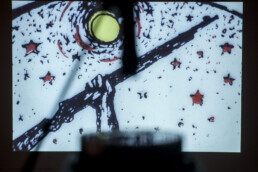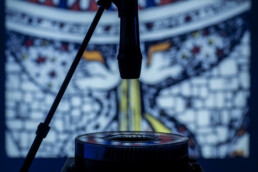ZORAN NASKOVSKI (1960)
Mandala and Cross / Farewell to Arms, 2014
installation (video projection, black–and-white, colour, double carousel slide projection / 2 x eighty colour slides, 2 slide projectors, 2 microphones, sound)
variable dimensions
Untitled 2/3, 2022
Video installation
Variable dimensions, 19’, loop
Edition: 1/5
Mandala and Cross / Farewell to Arms, 2014
installation (video projection, black–and-white, colour, double carousel slide projection / 2 x eighty colour slides, 2 slide projectors, 2 microphones, sound)
variable dimensions
The installation Mandala and Cross / Farewell to Arms is a series of crossed video and drawn-into-space carousel slide projections, which forms a space for a tense relationship between the scenes of empty holsters for weapons, used and discarded, and scenes of details from decorative plates, made in the Socialist Federal Republic of Yugoslavia by the Keramika Company from Bratunac, B&H. The stroboscopic method, based on the source of light that is rhythmically turned on and off, produces an intertwined sequence of the mentioned motifs. On the plates are the motifs of Yugoslav cities, painted in the form of mandalas, made in the early seventies, at the time of specific political turmoil, intensive armament and political shifts.
The installation Mandala and Cross / Farewell to Arms is part of the artist’s years-long project under the same name (Mandala and Cross), based primarily on researching, analysing and archiving of print media in real time. The connection between ornament and crime in this installation is set as a proposal for rethinking the aesthetic-political interaction characteristic of violence generated by ideologies, for rethinking what we recognize as strongly “branded” distortions, which now – through images of humanism and violence – have become an integral part of a universal process of “normalization”, which erases its conflicting origin.
© Cultural Centre of Belgrade, the October Salon Collection and the artist
Purchase Contract: III-5-158/25.5.2016.
Inventory No: 89
Photo: Courtesy the artist
Selected Bibliography:
Branislav Dimitrijević, “Zoran Naskovski: Mandala i krst / Zbogom oružje”, text for the exhibition, Nov. 25 – Dec. 1, 2014, Centre for Cultural Decontamination (CZKD), Belgrade, 2014, https://www.czkd.org/2014/11/follow-up-mandala-i-krst-zbogom-oruzje-zoran-naskovski/, accessed on Mar. 30, 2020
Branislav Dimitrijević, “Zoran Naskovski: Mandala i krst / Zbogom oružje”, BETON – kulturno propagandni komplet, No. 207, Year XIII, Belgrade, Tuesday, May 21, 2019, 4, https://www.elektrobeton.net/strafta/zoran-naskovski-mandala-i-krst-zbogom-oruzje/, accessed on Mar. 30, 2020
Untitled 2/3, 2022
Video installation
Variable dimensions, 19’, loop
Edition: 1/5
The Untitled 2/3 video installation is based on a juxtaposition of two events infused with the same idea, but that give off entirely different vibrations and prompt one to think about similar situations from any other social reality and a different period, particularly the current one. The two juxtaposed pieces of footage, although observed at a single visual plane, are two temporally adjacent events from the late 1960s that intend to convey positive and emancipatory ideas of counterculture. The footage out of the video beam shows the Indian musician Ravi Shankar’s 1967 performance at the Monterey pop festival, which is one of the most finely recorded public events with audience interaction in the history of film. The other two juxtaposed recordings are the day and evening footages of rock performers at the notorious 1969 Altamont festival, which used Hell’s Angels as security, but then descended into previously unseen violence precisely because of their behaviour and ideas.
© Cultural Centre of Belgrade, October Salon and the Artist Collection
Mining agreement: III-5-20/01.02.2023
Inventory no: 169
Photo: a square from the video, installation view
ABOUT THE AUTHOR:
Zoran Naskovski (1960, Izbište, Serbia) is a conceptual and media artist. His work and research entail avant-garde and modern art practices, a critique of manipulating images and information, political and economic violence, and institutional critique. He works within fine arts, in a wide array of media that include painting, video, installation, performance, photography, sound and internet projects. His works have been included in national exhibits, as well as international ones in museum and institutions such as the Whitney Museum in New York, the Andy Warhol Museum in Pittsburgh, Berkeley Museum in Berkeley, Wexner Center in Ohio, Tate Museum in London, Georges Pompidou Center in Paris, Neuer Berliner Kunstverein (n.b.k.) in Berlin, Fridericianum in Kassel, Kunsthalle Wien in Vienna, Ludwig Museum in Budapest, etc. In 2007, he participated in the central exhibition of the 52nd Venice Biennale Think with the Senses – Feel with the Mind. Art in the present Tense. He won several distinguished awards: The Nadežda Petrović Memorial in Čačak (1996), the award of the Belgrade Center for Contemporary Art’s annual exhibition (1997), the 44th (2003) and the 47th October Salon (2006), and Politika’s award for the best exhibition in 2020.





